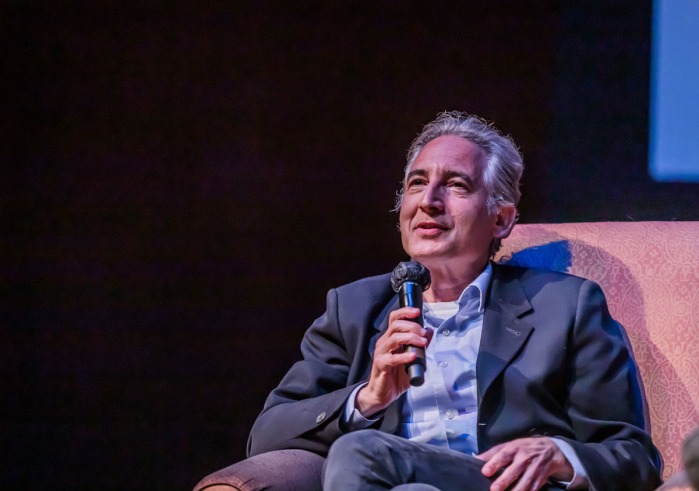Physicist Brian Greene Lectures on the True Meaning of Reality

Is physics “utterly stuck”? What is the meaning of mathematics? Does a multiverse exist? Are we a part of a simulation?
Those were some of the questions addressed by Brian Greene, the renowned theoretical physicist, in a conversation with Jim Merod, professor of American Literature at SUA, held in the Soka Performing Arts Center on April 29.
Vice President for Academic Affairs Michael Weiner introduced Greene, who is professor of physics and mathematics at Columbia University, chairman of the World Science Festival, and the author of several books, as dedicated “to enhancing public comprehension of the connection between science, philosophy, and the humanities.”
Though his work grapples with complex topics of superstring theory, the Washington Post called Greene “the single best explainer of abstruse concepts in the world today.” This skill of elucidation was on full display at Soka as he introduced groundbreaking theories and questions in modern physics to an audience with varying levels of knowledge in physics.
The conversation between Greene and Merod covered a variety of topics, including entanglement and wormholes, while also addressing their philosophical implications. Greene described biology, chemistry, mathematics, and quantum mechanics as languages we use to describe the universe, noting that some languages are more suitable for describing certain phenomena than others. For example, the motion of a ball, which is completely visible to us, is much better understood in classical physics, while it is easier to understand the behavior of tiny electrons using quantum mechanics.
The conversation was followed by a question-and-answer session with the audience. One audience member asked if Greene believed in a creator, which fueled a vigorous discussion about reality and existence. Greene described religion as “a powerful means by which our species has metaphorically addressed some of the deep questions of mortality and meaning.” While he did not completely rule out the possibility of the existence of a creator, he requires concrete evidence to prove it.
“The manner in which he combined physics with deeper questions about existence gave me many things to think about,” said Moses Odei Addai ’22, a reaction no doubt shared by many in the audience.
—Nugnandini Chhetri ’25
